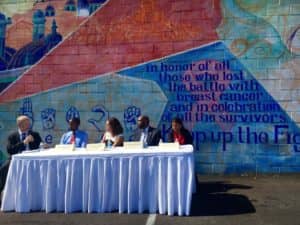Blueprint aims to attract immigrants to Pittsburgh region
 The Heinz Endowments President Grant Oliphant, far left, moderated a panel on the region’s challenges in attracting and retaining immigrants Tuesday at Salem’s Market and Grill in the Strip District. Panelists, from left to right, included: Kheir Mugwaneza of Northern Area Multi-Service Center; Rosamaria Cristello of the Latino Family Center; Quintin Bullock, president of Community College of Allegheny County; and Bishnu Timsina of the Bhutanese Community Association of Pittsburgh and Career Development Center.
The Heinz Endowments President Grant Oliphant, far left, moderated a panel on the region’s challenges in attracting and retaining immigrants Tuesday at Salem’s Market and Grill in the Strip District. Panelists, from left to right, included: Kheir Mugwaneza of Northern Area Multi-Service Center; Rosamaria Cristello of the Latino Family Center; Quintin Bullock, president of Community College of Allegheny County; and Bishnu Timsina of the Bhutanese Community Association of Pittsburgh and Career Development Center.
Natasha Lindstrom, Tuesday, Sept. 13, 2016
For decades, Western Pennsylvania has confronted a dilemma when it comes to immigrants: There haven’t been enough of them.
The demise of the domestic steel industry and shuttering of mills across Allegheny County spurred a population exodus while dissuading immigrants from moving here. Meanwhile, upticks in immigrants elsewhere buoyed economic growth there.
“In the ’80s, ’90s and 2000s, people were moving out,” Allegheny County Executive Rich Fitzgerald said. “Now, we have jobs. We have needs,” ranging from tech-savvy roles at burgeoning companies such as Google and Uber, to blue-collar jobs in manufacturing and at Shell’s planned ethane cracker plant in neighboring Beaver County.
“We need to bring talent in from everywhere.”
Fitzgerald joined elected officials, business leaders, nonprofit executives and immigrant groups Tuesday morning at Salem’s Market and Grill in the Strip District for the unveiling of the Immigrant Community Blueprint , one of the latest regional attempts to draw and retain more foreign-born residents.
The Blueprint contains recommendations organizations and businesses can implement over the next three to five years to attract and better serve immigrants. Among the suggestions: connect immigrants and refugees to free or low-cost workforce training programs, child care and health clinics; develop a repository of bilingual aides to assist in emergency situations; and collect more sophisticated data about foreign-born populations and their needs. Partnerships with nonprofits and educational groups will be essential to achieving outcomes.
“Blueprint offers a series of necessary actions that we want to see different organizations across the county take ownership of,” said Betty Cruz, who spearheaded the Blueprint effort with a $50,000 initial grant from The Heinz Endowments and anticipates support from The Pittsburgh Foundation, Hillman Family Foundation and Jefferson Regional Foundation.
Cruz recently left Mayor Bill Peduto’s office, where since 2014 she had helped with his “Welcoming Pittsburgh” immigrant initiative.
“The Blueprint is meant to be owned by the community,” said one of Tuesday’s panelists, Rosamaria Cristello of the Latino Family Center in Hazelwood. The Latino Family Center’s work includes doing an assessment to capture needs of the region’s Hispanic population — which is growing here at double the national rate.
The community-driven Blueprint builds on a decade of work by the Allegheny County Department of Human Services Immigrants and Internationals initiative, which supports immigrants in need of social services, as well as government-led efforts by Fitzgerald and Peduto.
“If we ever are going to see the full promise of what this city can be,” Peduto told Tuesday’s Strip District audience of several dozen community leaders and nonprofit and business representatives, “it’s going to be through an infusion of people that will come from throughout the world to help to build it — the same way that it was 100 years ago.”
Today, about one in 20 Allegheny County residents was born outside of the United States, and 27 percent of the region’s immigrants arrived within the past 10 years, Census data compiled by the Blueprint show.
Recent immigrant influxes have helped offset population declines in the region. Between 2000 and 2014, while the native population shrank by nearly 70,000 people, more than 18,000 immigrants arrived, census data compiled by the Blueprint show.
The two-person Blueprint project team will be based out of The Global Switchboard, a cultural and business incubator in Lawrenceville. The coordinating body will provide technical assistance and guidance to organizations unsure how to serve and include immigrants.
Panelist Bishnu Timsina of the Career Development Center caseworker and vice-chair of the Bhutanese Community Association of Pittsburgh, said she hopes the Blueprint will result in more people “making friends with their neighbors, the newcomers,” and more immigrant families feeling “safe and welcomed.”
http://triblive.com/news/allegheny/11135423-74/immigrants-blueprint-community
